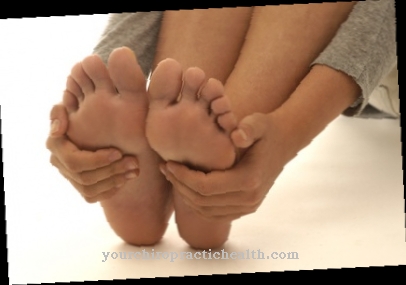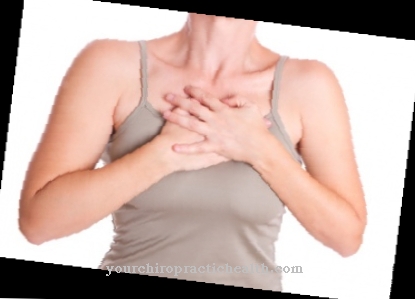Breastfeeding is best for both mother and child. No baby food comes close to the composition of breast milk with all its health benefits, this thesis is also considered undisputed among scientists. But even if breastfeeding is one of the most natural things in the world, problems often arise, especially in the early days. You can do one of these Painful breastfeeding be.
What is breastfeeding pain?

Breastfeeding pain includes all forms of physical discomfort during the breastfeeding process. Breastfeeding pain occurs mainly in the chest area, but can also be localized in the neck and back.
In particular, first-time mothers who have never breast-fed a child complain of pain when breastfeeding. The pain of breastfeeding can become so severe that a mother decides that she no longer wants to breastfeed her baby. If breastfeeding is generally desired, a precise diagnosis and, if possible, treatment of the breastfeeding pain should always be carried out before switching to artificial milk!
causes
The causes of pain when breastfeeding are often due to incorrect posture when breastfeeding. This is especially true if the pain is felt in the back and neck area and tends to subside quickly as soon as a different posture is adopted.
Improper breastfeeding posture can indeed cause great pain. For example, if the mother leans too far forward, the neck and back are stressed too much. Painful tension is the result. However, pain during breastfeeding can also result from disorders of the milk flow. So-called milk penetration occurs around two to five days after the birth. The chest is often red, swollen, and hot to the touch during this time. Laying the baby on is perceived as uncomfortable to painful.
Pain due to the milk penetration should not be assessed as pathological, but rather normal! The situation is different if the breastfeeding pain is caused by a breast infection. Breast tissue has become inflamed. Many women complain of severe malaise, often associated with a fever. Breast infection can result from blocked milk in the breast. It is a disease that should be checked by a doctor if it is very painful.
Diseases with this symptom
- Breast inflammation while breastfeeding
- mastitis
Diagnosis & course
If pain occurs during breastfeeding, the mother should first monitor it for its progress. Breastfeeding is a process that mother and child must first practice. If the pain recedes very quickly, in many cases it is simply an unfavorable sucking technique for the baby or initial problems with the mother.
If the pain remains while breastfeeding, a good diagnosis is essential. The midwife is a good contact here. If the midwife cannot help or if symptoms such as fever, severe exhaustion and vomiting occur, a pronounced breast infection should always be considered. In this case, a quick visit to the gynecologist should be pending.
This can palpate the chest and, if necessary, check blood values. In some cases, depending on the diagnostic results, it is necessary to prescribe an antibiotic.
Complications
Pain while breastfeeding can lead to complications if the mother is afraid of the pain and no longer dares to put on the baby regularly. Complications can also arise if pain during breastfeeding leads to unsuitable application techniques to the breast. If the baby cannot suckle properly from the breast or if it is no longer applied sufficiently often due to the mother's discomfort, the breast can no longer empty itself completely.
A milk blockage can develop from this as a compilation. This quickly creates a vicious circle without treating the cause of the pain: the blockage causes new pain, which in turn contributes to the inadequate or incorrect application. Breast infection can develop from a blocked breast. This may also have to be treated with antibiosis, otherwise the inflammation can spread to the whole body.
Midwives and gynecologists are therefore a good point of contact for painful breastfeeding, in order to avoid complications that naturally arise if the breast is not emptied sufficiently. Breastfeeding pain can also go away on its own. This is especially the case if the pain is primarily the result of unusual strain on the chest. If the breast is still drunk empty, no further complications are to be expected.
When should you go to the doctor?
The first pain when breastfeeding occurs in the maternity hospital. Since a doctor will still be present here, it is advisable to be informed about how this pain occurs and how long it can last. For example, if severe pain occurs after a caesarean section, the woman should insist on getting help with breastfeeding. This is usually done by the ward nurses.
All of these can help a new mom better manage the pain and wait for it to go away on its own. If pain occurs again in the weeks and months after breastfeeding, this is no longer normal and should be examined by a doctor. If symptoms such as difficult milk flow, swollen breasts, or red and irritated nipples occur at the same time, everything indicates a blocked milk or breast infection. This can happen, but it must be treated, otherwise the baby will no longer be fed.
Pain while breastfeeding can also be caused by the baby not docking properly or by biting while teething without knowing, of course, that it is hurting the mother. Some women are simply very sensitive to the breast and have to get used to the feeling. The gynecologist can help in these cases, but the aftercare midwife is also an understanding and knowledgeable contact person for all breastfeeding problems.
Doctors & therapists in your area
Treatment & Therapy
Treatment for breastfeeding pain depends on the cause. The most harmless causes are usually incorrect fitting techniques and incorrect posture when breastfeeding. Women should not be afraid to repeatedly ask their midwife for advice.
Every woman has the right to a home visit by a midwife who is currently observing the process of breastfeeding and advising accordingly. Midwives usually know little tricks to encourage the baby to improve their sowing technique. Products like nursing pillows can help lay the baby down better while breastfeeding. The nursing pillow helps that the mother does not have to bend forward too far. This protects your neck and back. In general, mothers should make sure that they sit as relaxed and upright as possible when breastfeeding. Breastfeeding can be comfortable!
Especially when the milk comes in, it is important to lay the baby on as often as possible so that the flow of milk is stimulated and the interplay of supply and demand can level out. Quark poultices can provide relief. Many hospitals also offer laser treatment in the first few days for heavily used nipples. This is painless and completely harmless to the flow of milk and the quality of the milk. In the case of a breast infection, treatment is to combat the inflammation.
In order to get the bacterial infection under control, it is usually necessary to prescribe a breastfeeding-friendly antibiotic. Breast infections are often associated with severe pain, especially when breastfeeding. These can also be treated symptomatically with appropriate painkillers. Many pain medications can be combined with breastfeeding in small doses, but should never be used without consulting a doctor or midwife.
Outlook & forecast
Breastfeeding pain is often caused by incorrect posture. The skeletal system and the muscles are put under incorrect stress and cause pain. A change in posture and the use of breastfeeding and pregnancy pillows help to achieve permanent pain relief. In addition, physical activity and stretching are helpful to relieve symptoms.
If you experience wart pain caused by breastfeeding, natural nipple care products can help reduce the discomfort. Together with the midwife, hints and tips for an optimal suction technique can be worked out to help with the healing process. If breast inflammation occurs, there is an increase in pain as breastfeeding continues. The breastfeeding method must then be reconsidered and changed. In some cases it is necessary to discontinue breastfeeding, as pathogens can enter the newborn's organism through breast milk. After a few weeks, the inflammation will usually heal completely.
If the pain is triggered by a blocked milk, there is an imbalance between the milk produced and the milk used. The mother can express the excess breast milk to achieve pain relief. With weaning, the pain will disappear permanently. Only in very rare cases will there be further impairments or complaints.
prevention
The best way to prevent pain while breastfeeding is to maintain an optimal posture while breastfeeding and to hold the infant frequently. Most women find midwifery help useful here. Those who want to prevent pain can find out about breastfeeding in advance and also after the birth in special nursing cafés in the hospital.
Many maternity clinics offer such meetings, which are often led by pediatric nurses and midwives. Here, too, mothers have the opportunity to ask questions about breastfeeding and, if necessary, to have their posture and fitting technique corrected.
You can do that yourself
Breastfeeding pain puts a strain on the breastfeeding relationship and must go away quickly if it occurs. Immediately after birth, they are unfortunately normal and are even more pronounced in caesarean section patients. They in particular must insist on help with breastfeeding. Immediately after the caesarean section, the baby must not lie on the mother's stomach, as this will only make the pain worse - at best, someone else will hold it.
Women who have given birth spontaneously can also insist on help with breastfeeding. If they stay in the maternity hospital for a few more days, the ward nurses can demonstrate different breastfeeding positions that may make things easier. If breastfeeding pain occurs due to causes such as breast inflammation or congestion, expressing is a sensible solution. The attachments of special feeding bottles for breast milk are made similar to a nipple, which is supposed to prevent the baby from developing nipple confusion when switching to expressed milk at short notice. Meanwhile, the mother can express milk at her own pace and is in less pain than if the baby were to suckle during this time.
At the same time, of course, the cause of the pain when breastfeeding must be eliminated so that the baby does not have to be bottle-fed for too long. If pain persists and breastfeeding is therefore very poor, weaning is a last option, but it should be avoided if possible.



























